Human uses of scorpions
Humans use scorpions both practically, for medicine, food, and pets, and symbolically, whether as gods, to ward off harm, or to associate a product or business with the evident power of the small but deadly animal.
Practical uses[]
Medicine[]

Short-chain scorpion toxins constitute the largest group of potassium (K+) channel-blocking peptides. An important physiological role of the KCNA3 channel, also known as KV1.3, is to help maintain large electrical gradients for the sustained transport of ions such as Ca2+ that controls T lymphocyte (T cell) proliferation. Thus KV1.3 blockers could be potential immunosuppressants for the treatment of autoimmune disorders (such as rheumatoid arthritis, inflammatory bowel disease, and multiple sclerosis).[2] The venom of Uroplectes lineatus is clinically important in dermatology.[3]
Several scorpion venom toxins have been investigated for medical use. Chlorotoxin from the deathstalker scorpion (Leiurus quinquestriatus); the toxin blocks small-conductance chloride channels;[1][4] Maurotoxin from the venom of the Tunisian Scorpio maurus blocks potassium channels.[5] Some antimicrobial peptides in the venom of Mesobuthus eupeus; meucin-13 and meucin-18 have extensive cytolytic effects on bacteria, fungi, and yeasts,[6] while meucin-24 and meucin-25 selectively kill Plasmodium falciparum and inhibit the development of Plasmodium berghei, both malaria parasites, but do not harm mammalian cells.[7]
Food[]
Fried scorpion is traditionally eaten in Shandong, China.[8]
As pets[]

Scorpions are sometimes kept as pets, in the same way as other dangerous animals like snakes and tarantula spiders. Popular Science Monthly carried an article entitled "My pet scorpion" as early as 1899.[9]
Symbolic uses[]
Middle Eastern culture[]
The scorpion is a significant animal culturally, appearing as a motif in art, especially in Islamic art in the Middle East.[10] A scorpion motif is often woven into Turkish kilim flat-weave carpets, for protection from their sting.[11] The scorpion is perceived both as an embodiment of evil and a protective force such as a dervish's powers to combat evil.[10] In another context, the scorpion portrays human sexuality.[10] Scorpions are used in folk medicine in South Asia, especially in antidotes for scorpion stings.[10]
One of the earliest occurrences of the scorpion in culture is its inclusion, as Scorpio, in the 12 signs of the Zodiac by Babylonian astronomers during the Chaldean period.[12] In ancient Egypt, the goddess Serket was often depicted as a scorpion, one of several goddesses who protected the Pharaoh.[13]
Alongside serpents, scorpions are used to symbolize evil in the New Testament. In Luke 10:19 it is written, "Behold, I give unto you power to tread on serpents and scorpions, and over all the power of the enemy: and nothing shall by any means hurt you." Here, scorpions and serpents symbolize evil.[14] Revelation 9:3 speaks of "the power of the scorpions of the earth."[15]

Early Bronze Age Jiroft culture scorpion game board, Iran

A scorpion motif (two types shown) was often woven into Turkish kilim flatweave carpets, for protection from their sting.[11]
Western culture[]
The scorpion with its powerful sting has been used as the name or symbol of various products and brands, including Italy's Abarth racing cars.[16] In the Roman army, the scorpio was a torsion siege engine used to shoot a projectile.[17] The British Army's FV101 Scorpion was an armoured reconnaissance vehicle or light tank in service from 1972 to 1994.[18] It holds the Guinness world record for the fastest production tank.[19] A version of the Matilda II tank, fitted with a flail to clear mines, was named the Matilda Scorpion.[20] Several ships of the Royal Navy have been named HMS Scorpion, including an 18-gun sloop in 1803,[21] a turret ship in 1863,[22] and a destroyer in 1910.[23] A hand- or forearm-balancing asana in modern yoga as exercise with the back arched and one or both legs pointing forwards over the head is called Scorpion pose.[24] A variety of martial arts films and video games have been entitled Scorpion King.[25][26][27] A Montesa scrambler motorcycle was named Scorpion.[28]
Scorpions have equally appeared in western artforms including film and poetry: the surrealist filmmaker Luis Buñuel made symbolic use of scorpions in his 1930 classic L'Age d'or (The Golden Age),[29] while Stevie Smith's last collection of poems was entitled Scorpion and other Poems.[30]

The Roman army used scorpio siege engines.[17]

"Scorpion and snake fighting", Anglo-Saxon Herbal, c. 1050

Portrait of Elisabetta Gonzaga, Raphael, c. 1504

"Libra and Scorpio". Star map by John Flamsteed, 1776

"The Italian Boot": King Victor Emmanuel II of Italy shaking Giuseppe Mazzini from the boot of Italy

Still life with scorpion and frog by Hermenegildo Bustos, 1874

1975 Montesa King Scorpion motorcycle
Other cultures[]
Scorpions are among the many animals modelled in the art of the Moche culture of Peru.[31] Mimbres artists in the south of New Mexico created painted ceramics of scorpions and many other symbolic and mythological animals on funerary bowls. A hole was ritually punched through the bottom of the bowl to "kill" it during a funeral.[32]

Moche scorpion ornament in gilded copper, Peru, 6th to 7th century AD

Mogollon (Mimbres) ceramic scorpion bowl, New Mexico, 950-1150 AD

Gold ornament with scorpion and centipede, Qingyang, China

Anomalobuthus rickmersi on a Kazakhstan postage stamp, 1997
References[]
- ^ a b DeBin, J. A.; G. R. Strichartz (1991). "Chloride channel inhibition by the venom of the scorpion Leiurus quinquestriatus". Toxicon. 29 (11): 1403–1408. doi:10.1016/0041-0101(91)90128-E. PMID 1726031.
- ^ Chandy, K. George; Heike Wulff; Christine Beeton; Michael Pennington; George A. Gutman; Michael D. Cahalan (May 2004). "K+ channels as targets for specific immunomodulation". Trends in Pharmacological Sciences. 25 (5): 280–289. doi:10.1016/j.tips.2004.03.010. PMC 2749963. PMID 15120495.
- ^ Rapini, Ronald P.; Bolognia, Jean L.; Jorizzo, Joseph L. (2007). Dermatology: 2-Volume Set. St. Louis: Mosby. p. 1315. ISBN 978-1-4160-2999-1.
- ^ Deshane, Jessy; Craig C. Garner; Harald Sontheimer (2003). "Chlorotoxin inhibits glioma cell invasion via matrix metalloproteinase-2". Journal of Biological Chemistry. 278 (6): 4135–4144. doi:10.1074/jbc.M205662200. PMID 12454020.
- ^ Carlier, E.; S. Geib; M. De Waard; V. Avdonin; T. Hoshi; Z. Fajloun; H. Rochat; J.-M. Sabatier; R. Kharrat (2000). "Effect of maurotoxin, a four disulfide-bridged toxin from the chactoid scorpion Scorpio maurus, on Shaker K+ channels". . 55 (6): 419–427. doi:10.1034/j.1399-3011.2000.00715.x. PMID 10888198.
- ^ Gao, Bin; Patrick Sherman; Lan Luo; John Bowie; Shunyi Zhu (2009). "Structural and functional characterization of two genetically related meucin peptides highlights evolutionary divergence and convergence in antimicrobial peptides". FASEB Journal. 23 (4): 1230–1245. doi:10.1096/fj.08-122317. PMID 19088182. S2CID 13235803.
- ^ Gao, Bin; Jia Xu; Maria del Carmen Rodriguez; Humberto Lanz-Mendoza; Rosaura Hernández-Rivas; Weihong Du; Shunyi Zhu (2010). "Characterization of two linear cationic antimalarial peptides in the scorpion Mesobuthus eupeus". Biochimie. 92 (4): 350–359. doi:10.1016/j.biochi.2010.01.011. PMID 20097251.
- ^ Forney, Matthew (June 11, 2008). "Scorpions for Breakfast and Snails for Dinner". The New York Times.
- ^ a b Robinson, Norman (1899). "My pet scorpion". Popular Science Monthly. 54: 605–613.
- ^ a b c d Frembgen, Jürgen Wasim (2004). "The scorpion in Muslim folklore". Asian Folklore Studies. 63 (1): 95–123.
- ^ a b Erbek, Güran (1998). Kilim Catalogue No. 1 (1st ed.). May Selçuk A. S.
- ^ Polis, Gary (1990). The Biology of Scorpions. Stanford University Press. p. 462. ISBN 978-0-8047-1249-1. OCLC 18991506.
- ^ a b "Pharaonic Gods". Egyptian Museum. 13 May 2008. Archived from the original on 13 May 2008.
- ^ Pulpit Commentary on Luke 10, accessed 29 October 2018
- ^ Revelation 9:3
- ^ "Abarth Logo: Design and History". Famouslogos.net. Archived from the original on 11 June 2013. Retrieved 2011-07-28.
- ^ a b Vitruvius, De Architectura, X:10:1-6.
- ^ a b "FV101 Scorpion: Keeping the Light Tank Relevant". HistoryNet. Retrieved 23 June 2020.
- ^ "Fastest tank". Guinnessworldrecords.com. 26 March 2002. Retrieved 31 May 2014.
- ^ Fletcher, David (2017). British Battle Tanks: British-made Tanks of World War II. Bloomsbury. p. 37. ISBN 978-1-4728-2003-7.
- ^ Winfield, Rif (2008). British Warships in the Age of Sail 1793–1817: Design, Construction, Careers and Fates. Seaforth. p. 291. ISBN 978-1-86176-246-7.
- ^ Parkes, Oscar (1990). British Battleships (reprint of the 1957 ed.). Annapolis, MD: Naval Institute Press. pp. 78–79. ISBN 1-55750-075-4.
- ^ The Times (London), Wednesday, 31 August 1910, p. 5
- ^ a b YJ Editors; Budig, Kathryn (1 October 2012). "Kathryn Budig Challenge Pose: Scorpion in Forearm Balance". Yoga Journal.
{{cite journal}}:|last1=has generic name (help) - ^ Wallis, J. Doyle (2004). "Operation Scorpio". DVD Talk. Retrieved 2015-06-19.
- ^ "The Scorpion King". Box Office Mojo. Retrieved 4 January 2010.
- ^ Provo, Frank (2002). "The Scorpion King: Sword of Osiris Review". GameSpot. Retrieved 24 June 2020.
- ^ Salvadori, Clement (17 January 2019). "Retrospective: 1974-1977 Montesa Cota 247-T". Rider Magazine. Retrieved 25 June 2020.
Permanyer persisted, built larger engines, and in 1965 showed the 247cc engine (21 horsepower at 7,000 rpm) in a Scorpion motocrosser.
- ^ Weiss, Allen S. (1996). "Between the sign of the scorpion and the sign of the cross: L'Age d'or". In Rudolf E. Kuenzli (ed.). Dada and Surrealist Film. MIT Press. pp. 159–175. ISBN 978-0-262-61121-3.
- ^ "Stevie Smith: Bibliography". Poetry Foundation. Retrieved 1 July 2019.
- ^ "Scorpion ( Accession Number: 1981.459.5)". Metropolitan Museum of Art. Retrieved 28 June 2020.
- ^ "Bowl, Scorpions". Metropolitan Museum of Art. Retrieved 28 June 2020.
- Animals in human culture
- Scorpions and humans
















